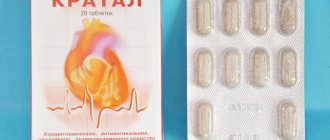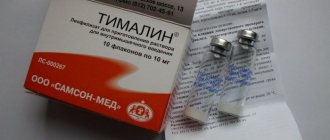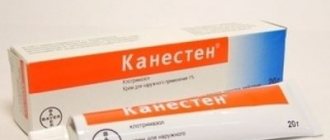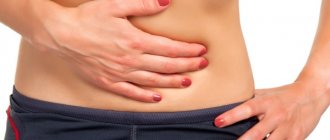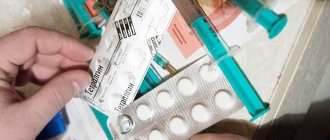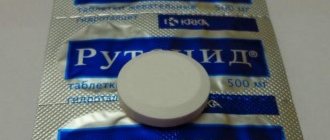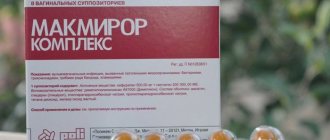Pharmacological properties
The active substance of the drug is terbinafine, which is an allylamine derivative and has a broad antifungal effect. The drug is active against dermatophytes: Trichophyton mentagrophytes, Trichophyton tonsurans, Epidermophyton floccosum, Microsporum canis, Trichophyton rubrum, Trichophyton verrucosum, Trichophyton violaceum. It has a fungicidal effect against molds (Aspergillus, Scopulariopsis brevicaulis Cladosporium), as well as some types of dimorphic fungi.
Like most analogues, Fungoterbin does not affect hormone synthesis.
Release form and composition of the ointment
With the exception of the main active component, which is the same everywhere, the composition of Fungoterbine depends on the form of release. There are three of them:
- ointment or cream;
- spray;
- pills.
Fungoterbin ointment contains 100 grams of terbinafine hydrochloride. The rest comes from excipients: dibunol, petroleum jelly, paraffin, propylene glycol, cytostearyl and stearyl cream, urea and water.
The active substance spray contains 10 milligrams per 1 gram of medicine. The auxiliary components are urea, propylene glycol, ethanol, butylated hydroxytoluene and povidone.
As for tablets, the active ingredient per tablet is 250 milligrams. The remaining components are benzoic acid, aerosil, collidone, magnesium stearate and MCC.
Attention! All forms of the drug are equally bioavailable, both before and after meals.
Fungoterbin dosage and instructions for use
The duration of the therapeutic course and dosage are set individually, according to the severity of the disease and the degree of localization of the process.
Adult patients are prescribed 1 tablet (250 mg) after meals, 1 time per day. In the presence of renal or liver failure, the dosage is 1/2 tablet, once a day.
For mycoses of the skin, the course of treatment recommended by the Fungoterbin instructions is 2-6 weeks.
For onychomycosis: The recommended course of therapy is 6-12 weeks.
A stable clinical effect is recorded several months after completion of therapy.
Fungoterbin cream is applied to the skin surface 1-2 times a day. It is necessary to clean the affected skin area before applying the drug to it. The cream is applied to the affected area in a thin layer with light rubbing.
Average duration of therapy:
• For dermotoxicosis of the legs or torso: 1 time per day for 1 week;
• For dermatomycosis: 1 time per day for one week;
• For lichen versicolor: 1-2 times a day for 2 weeks;
• For skin candidiasis: 1-2 times a day for 1-2 weeks.
The drug can be used for children over two years of age. For body weight less than 20 kilograms - 1/4 tablet, from 20 kg to 40 kg - 1/2 tablet, over 40 kg - one tablet per day. No reviews were received on the use of Fungoterbine in patients under 2 years of age.
Contraindications
The main contraindications for use in the instructions are indicated for its external dosage forms. They are quite typical for a product of this class and include:
- allergy to one of the components of the ointment or spray;
- too young;
- pregnancy.
During pregnancy or lactation, external forms are used strictly as prescribed by the doctor, if there is confidence that the benefit to the mother’s body is higher than the risk. As for the minimum age, it is 12 years.
There are a number of contraindications for tablets. They include:
- chronic liver or kidney failure;
- intolerance to terbinafine;
- pregnancy and lactation;
- lactase deficiency;
- age up to three years.
Attention! It is worth noting that medical supervision when taking the drug is also necessary in case of problems with blood circulation and metabolism, lupus erythematosus, tumors, and alcoholism. The doctor may adjust the dosage as the course progresses.
Side effects of Fungoterbin
Possible side effects of Fungoterbine are mild and last a short time. When taken orally, the following side effects may occur:
• dyspepsia, loss of appetite, abdominal pain, diarrhea, nausea;
• joint pain, muscle pain;
• neutropenia, thrombocytopenia, lymphopenia.
Possible manifestations of allergic reactions: skin rash in the form of blisters, spots, toxic epidermal necrolysis, anaphylactoid reactions.
Indications
The drug Fungoterbin is indicated for the treatment of any stage of onychomycosis. Since it contains certain substances that have a gentle effect on healthy tissue, this cream is often used to treat skin areas around the nail that are susceptible to fungal infection.
The cream is used in complex therapy against various types of candidiasis that cause damage to the intestines or esophagus, as well as for lesions of the nails by certain types of fungi, mycoses of the feet and lesions in the interdigital folds, epidermophytosis of large folds on the body, and the formation of various types of lichen.
Fungoterbine oral tablets
Instructions for medical use of the drug
Description of pharmacological action
Terbinafine, the active substance of Fungoterbine®, is an allylamine and has a broad spectrum of antifungal action. Active against dermatophytes such as Trichophyton (T. rubrum, T. mentagrophytes, T. tonsurans, T. verrucosum, T. violaceum), Microsporum canis, Epidermophyton floccosum. In low concentrations, it has a fungicidal effect against dermatophytes, molds (Aspergillus, Cladosporium, Scopulariopsis brevicaulis, etc.) and some dimorphic fungi. The effect on yeast fungi of the genus Candida and its mycelial forms can be fungicidal or fungistatic, depending on the type of fungus. Terbinafine is also active against Pityrosporum, the causative agent of pityriasis versicolor, Pityriasis versicolor, caused by Pityrosporum ovale. Terbinafine disrupts the biosynthesis of ergosterol occurring in fungi in the early stages. This leads to ergosterol deficiency and intracellular accumulation of squalene, which causes the death of the fungal cell. Terbinafine acts by inhibiting the enzyme squalene epoxidase located on the cell membrane of the fungus. This enzyme does not belong to the cytochrome P450 system. Terbinafine does not affect the metabolism of hormones or other drugs. Due to the presence of urea in the cream and spray, the drug has a moisturizing effect, promotes deeper penetration of terbinafine into the skin and, thus, creates high concentrations in it. For the spray additionally: carbamide (urea), which is part of the spray, has a keratolytic effect (softening and causing rejection of the stratum corneum of the epidermis affected by fungal infection). Urea promotes rapid restoration of the epidermis. Butylated hydroxytoluene is an antioxidant that stimulates regeneration processes. When applied topically, it inhibits free radical reactions.
Indications for use
Tablets: - onychomycosis; — mycoses of the scalp (trichophytia, microsporia); — candidiasis of the skin and mucous membranes caused by fungi of the genus Candida in cases where the localization or extent of the process determine the advisability of oral therapy; - fungal diseases of smooth skin (common dermatomycosis of the trunk and extremities). Cream and spray: Treatment and prevention of fungal skin diseases: - fungal skin infections, incl. mycoses of the feet (“fungus” of the foot), inguinal athlete’s foot (tinea cruris), fungal infections of the smooth skin of the body (tinea corporis) caused by dermatophytes such as Trichophyton (including T. rubrum, T. mentagrophytes, T. verrucosum, T. violaceum), Microsporum canis and Epidermophyton floccosum; - skin infections caused by yeast-like fungi of the genus Candida (for example Candida albicans); - Versicolor versicolor (Pityrosporum versicolor), caused by Pityrosporum orbiculare (also known as Malassezia furfur). Spray additionally: seborrheic dermatitis of the scalp (dandruff).
Release form
tablets 250 mg; packaging contour charunkova 7, cardboard pack 2; tablets 250 mg; packaging contour charunkova 10, cardboard pack 1; tablets 250 mg; packaging contour charunkova 7, cardboard pack 1; tablets 250 mg; packaging contour charunkova 10, cardboard pack 2; Warehouse Tablets 1 tab. terbinafine 250 mg additional words: MCC; collidon CL-M; collidon 30; aerosil; benzoic acid; magnesium stearic acid - sufficient strength to remove tablets weighing 0.37 g in a contoured package of 7 or 10 pcs.; In a cardboard pack there are 1 or 2 packages. Cream 1% 100 g terbinafine hydrochloride 1 g additional substances: butylhydroxytoluene (dibunol) - 0.1; sechovina (urea); cetostearyl ether macrogol 20; cetostearyl alcohol; proxanol-268 (poloximer 407); Imidosechovina; propylene glycol; medical vaseline oil (rare paraffin); purified water - up to 100 g in aluminum tubes 15 g each; There is 1 tube in a cardboard pack. Spray for external consolidation 100 g terbinafine hydrochloride 1 g additional substances: kernel (carbamide) - 1 g; butylhydroxytoluene (dibunol) - 1 g; ethyl alcohol 95% (ethanol); Low molecular weight medicinal PVP (povidone, collidon), propylene glycol - up to 100 g in a polymer bottle of 15 or 30 ml; 1 bottle in a cardboard pack.
Pharmacodynamics
Terbinafine is the active derivative of Fungoterbine®, which is an alylamine and has a wide spectrum of antifungal activity. Active in such dermatophytes as Trichophyton (T. rubrum, T. mentagrophytes, T. tonsurans, T. verrucosum, T. violaceum), Microsporum canis, Epidermophyton floccosum. At low concentrations it exhibits fungicidal activity against dermatophytes, mold fungi (Aspergillus, Cladosporium, Scopulariopsis brevicaulis, etc.) and various dimorphic fungi. The action on yeast fungi of the genus Candida and its mycelial forms can be fungicidal or fungistatic, depending on the type of fungus. Terbinafine is also active in Pityrosporum - the common fungus Pityriasis versicolor, also known as Pityrosporum ovale. Terbinafine disrupts the biosynthesis of ergosterol in fungi at early stages. This leads to a deficiency of ergosterol and to the internal accumulation of squalene, which causes the death of the fungal cell. The action of terbinafine is due to the inhibition of the enzyme squalene oxidase, which is present on the cell membrane of the fungus. This enzyme does not belong to the cytochrome P450 system. Terbinafine does not affect the metabolism of hormones or other drugs. Although it is evident in creams and sprays, the drug has a oxidizing effect, allows terbinafine to penetrate more deeply into the skin and, thus, creates high concentrations in it. For the spray, additionally: carbamide (carbamide), which is included in the spray, is keratolytic (swelling and swelling of the epidermis affected by fungal infection of the horny ball). Carbamide provides a smooth, renewed epidermis. Butylhydroxytoluene is an antioxidant that stimulates regeneration processes. When locally stagnated, the inhibitor causes a completely radical reaction.
Pharmacokinetics
Hedgehog tablets do not affect bioavailability. After a single dose of terbinafine internally at a dose of 250 milligrams, the Cmax of the drug in the blood plasma reaches after 2 years and becomes 0.97 mcg / ml. The drug is well absorbed when taken orally (about 70%), bioavailability becomes 40%. Terbinafine intensively binds to blood plasma proteins (99%), quickly penetrates the dermal ball of the skin and accumulates in the horny ball of the skin and nail plates, providing a fungicidal action. Shvidko penetrates into the secretion of sebaceous glands, resulting in a high concentration in the hair follicles, hair, as well as in the skin, under the skin. Biotransforms in the liver with the release of inactive metabolites; Approximately 70% of the administered dose is excreted. T1/2 - close to 17 years old. T1 / 2 in the terminal phase - 200-400 years. Does not accumulate in the body. There was no change in the equal concentration of terbinafine over time; In patients with nitric deficiency or in patients with liver cirrhosis, the fluidity of the drug can be increased to produce higher concentrations of terbinafine in the blood plasma. Cream and spray When locally stagnant, less than 5% of the dose is absorbed, so the systemic effect of the drug is minimal.
Use during pregnancy
Fungoterbin® spray and cream. In experimental studies, no teratogenic effects of terbinafine were identified. Until now, there was no information about any kind of development when Fungoterbin® was frozen in the form of a spray or cream. In case of clinical evidence for the use of the drug in pregnant women even in the area, use Fungoterbin® spray and cream according to the following indications only, if the bark for the mother is transferred to the potential risk for the fetus. . Terbinafine is seen in breast milk. However, when the mother drug Fungoterbin® spray and cream is frozen, a small amount of active substance is absorbed through the skin, so the unpleasant influx into the mouth is unlikely.
Contraindications for use
For all dosage forms, sensitivity to terbinafine or any other component that is included in the drug is increased. With caution: - tablets; - alcoholism; - blood disease; - puffiness; - illness and speech exchange; — pathology of the veins; - child age up to 2 years; - cream; - pechenkova and/or nirkova deficiency; - alcoholism; - illness and speech exchange; — pathology of the veins; - child age up to 12 years. There is no information about stagnation during pregnancy. Spray has additional contraindications in children (up to 12 days). With care: - pechenkova and/or nirkova deficiency; - alcoholism; — suppression of cystic-cerebral hematopoiesis; - puffiness; - illness and speech exchange; - occlusive disease of the ends of the vessels.
Side effects
Fungoterbin® tablets are generally well tolerated. Side effects may be expressed weakly or peacefully and have a temporary character. When taken orally, you may be careful about: - on the side of the thyroid gland: dyspepsia, abdominal pain, swelling of the vulva, boredom, loss of appetite, diarrhea; Others - destruction of savory substances, including their loss (renewed a few years after the end of the treatment); - on the side of the cartilage-muscle system: pain in the muscles, pain in the forehead; - on the side of the hematopoietic system: neutropenia, agranulocytosis, thrombocytopenia; rarely - lymphopenia; — allergic reactions: skin visip in the appearance of spots, fluff; rarely - toxic epidermal necrolysis, Stevens-Johnson syndrome, anaphylactoid reactions. Cream and spray In rare cases, there was a redness, itching or liver in the place where the cream was applied, and the symptoms rarely led to the need to take a bath. The above-mentioned symptoms can be classified as allergic reactions (for example, urticaria, generalized vysypta / or erythema, angioedema, repeated allergic reaction), which occur rarely, but do not occur when When you appear, it is necessary to celebrate.
Directions for use and doses
Tablets Orally, after meals. The duration of treatment and dosage regimen are determined individually and depend on the location of the process and the severity of the disease. When we grow up, take 1 tablet. (250 mg) 1 time per dose. Patients with liver and nitric deficiency - 1/2 table. (125 mg) 1 time per day. Skin mycoses. The following three treatments are recommended: dermatomycosis of the feet (interdigital, plantar or “scarpet” type) - 2-6 days; dermatomycosis of the tube, ends - 2-4 years; candidiasis of the skin and mucous membranes - 2-4 degrees. The occurrence of clinical manifestations of illness is usually avoided within a few days after mycological treatment. Mycoses of the scalp. The recommended length of bathing is: mycosis of the scalp - about 4 days. Mycosis of the scalp is especially important to avoid in children. Onychomycosis The duration of treatment with the drug in most patients is 6-12 days. With onychomycosis of the fingers of the hands, most of the joints should be 6 degrees, and with onychomycosis of the toes - 12 degrees. Those who are ill and may experience decreased fluidity of nail growth may require more treatment. The optimal clinical effect is achieved several months after mycological treatment and therapy. This is determined by this period of time, which is necessary for the growth of a healthy nail. The drug is prescribed for children for two reasons. The dose is based on the child's body weight: children with body weight up to 20 kg - 62.5 mg / dose (1/4 tablet); from 20 to 40 kg - 125 mg / dose (1/2 tablet); over 40 kg - 250 mg / dose (1 tablet). Data on the use of the drug in children up to 2 years of age (with body weight Externally, adults and children over 12 years of age. Apply the cream 1 or 2 times per day with a thin ball on the surface (first cleansing and drying) and lay down on them skin and rub lightly In case of infections that occur nearby (under the mammary tract, in the interdigital spaces, between the sores, at the groin area), the place where the cream is applied can be covered with gauze, especially at night. no, adults and children over 12 years old 1 or 2 times per in order to powder the wounds and the plots of both damaged and intact skins in a quantity sufficient for their retinal formation. Why is it not recommended for children under 12 years of age? Average treatment frequency for both forms: - dermatomycosis of the trunk, homilok and feet - 1 time per day for 1 day; - candidiasis of the skin - 1-2 times per day for 1-2 days; - lichen versicolor - 1-2 times per day 1 stretch.
Overdose
Tablets Until now, overdose of Fungoterbin when taken orally in recommended doses has not been described. Symptoms (in case of acute overdose): possible - boredom, vomiting, pain in the epigastric area. Likuvannya: washing the shluk with further significance of the active vugill; when necessary, symptomatic supportive therapy. Cream and spray If you take it occasionally, you may experience the same symptoms as with an overdose of tablets. Spray additionally: mix with alcohol instead of the preparation.
Interactions with other drugs
Terbinafine tablets in vitro can very little alter the clearance of most drugs that are metabolized via the cytochrome P450 system (for example, cyclosporine, terfenadine, tolbutamide, triazolam or oral contraceptives c). Women who simultaneously take terbinafine and oral contraceptives may experience disruption to their menstrual cycle. The final clearance of terbinafine can be accelerated by drugs that induce the induction of cytochrome P450 enzymes (for example, rifampicin) and can be influenced by drugs that are inhibitors of the cytochrome system. P450 (for example, cimetidine), if it is necessary to insulate these drugs for one hour, a dose adjustment may be necessary. Reduces caffeine clearance by 20%. Fungoterbin® does not affect the clearance of antipyrine, digoxin, and warfarin. Ethanol and other hepatotoxic drugs increase the risk of hepatotoxicity. There is no known interaction between the drug Fungoterbin®spray and the cream.
Precautions for use
With regular cleansing or early administration, there is a significant risk of re-infection.
Special instructions for use
Tablets Irregular use or premature completion of treatment promotes the risk of relapse. If after the next 2 treatments there is no evidence of progression, it is necessary to re-assess the symptoms of illness and sensitivity to the drug. Caution should be exercised when taking Fungoterbin® because we suffer from impaired liver function or poor liver function. If symptoms are detected that suggest impaired liver function (loss of appetite, nausea, persistent boredom, chewing, dark spots), it is necessary to discontinue the drug. For patients with chronically impaired liver function, use half the original recommended dose of the drug and monitor indicators of liver function and during the healing process. When used as Fungoterbin® for local congestion, Fungoterbin® tablets are not effective for varicose veins. During the process and at the end of the bath, it is necessary to carry out antifungal treatment on the insides, socks and panties. Data about the infusion of Fungoterbin® for the ability to drive a car and operate machinery that requires respect on a daily basis. Tilki cream for external congealing. There is no trace of the cream getting into your eyes. If after 2 further treatments there is no sign of swelling, you should check the correctness of the diagnosis. Individuals of summer age do not need to change dosage. With the use of the drug, it goes away, as if the negative influx is very low, then systemic absorption through the skin is very little. Spray Changes in the severity of clinical manifestations are usually detected in the first days of treatment. There is a risk of recurrent infection in cases of irregular bathing or premature use. There is no trace of spray in the eyes or on the mucous membranes. If after 2 further treatments there is no sign of swelling, you should check the correctness of the diagnosis. If you accidentally get the drug in your eyes, carefully rinse the traces with running water, and if you suddenly develop persistent symptoms, you should consult a doctor.
Storage conditions
List B.: At a temperature not exceeding 20 ° C.
Best before date
24 months
ATX classification:
D Dermatotropic drugs
D01 Antifungal drugs for the treatment of skin diseases
D01A Antifungal drugs for external use
D01AE Other antifungal preparations for external use
D01AE15 Terbinafine
Doctors' reviews about Fungoterbin cream
Krymov V.I. dermatologist:
I consider Fungoterbin cream a wonderful remedy for treating fungus; it has proven itself to be an effective remedy at any stage of the disease. It is quite affordable; rarely do patients complain about its high cost. It helps well with nail damage, especially if treatment is started in a timely manner and the treatment regimen is followed. Among the disadvantages, it should be noted that treatment must be carried out for a long time; if stopped prematurely, a relapse may develop.
Alekseev P.V. dermatologist, 12 years of experience:
I often prescribe the cream to treat my patients. Firstly, it is a broad-spectrum drug and fights the most common types of fungus, and secondly, it has virtually no contraindications and can be used even in the presence of chronic pathologies. The drug is well and completely absorbed and is used sparingly. Interdigital fungus, which is the most common fungal infection, can be completely eliminated with this medicine a week after the first application.
special instructions
From the first days of using the cream, there is a decrease in the symptoms of the disease with a decrease in the severity of its clinical nature. However, there is a possibility of resumption of infection at any stage if the regularity of taking Fungoterbine is disrupted or if it is discontinued prematurely. Particular attention should be paid to the degree of development of the infectious process, so if no improvement has occurred within two weeks from the start of therapy, you should consult a doctor to clarify the diagnosis or prescribe another drug.
When using Fungoterbine cream, it is necessary to prevent it from coming into contact with mucous membranes and the eye area. If this happens due to carelessness, then it is necessary to rinse your eyes with running cold water. If irritation develops over a long period of time, medical advice should be sought.
Analogs
Since fungal infections are considered one of the most common diseases, and the incidence rate is not going to decrease, medicine is concerned about the increase in this process. In this regard, patients are offered the latest drugs that can help them cope with fungal infections. Fungoterbin cream is considered to be quite effective in eliminating various fungi, but in some cases it needs to be replaced with similar medications. The most popular drugs that have proven effective in the treatment of fungal diseases and have the same properties as Fungoterbin cream are:
- Oronazole;
- Hexicon;
- Lamicon;
- Genferon;
- Dermazol;
- Nystatin;
- Triderm;
- 5-NOK;
- Diflazon;
- Vocadine;
- Exiter.
There are a large number of other drugs designed to eliminate fungal infections. Each of them has its own characteristic properties, which should be taken into account based on the nature of the lesion.
Dear readers! You can leave your feedback on the use of Fungoterbin cream in the comments below, they will be useful to other users!
